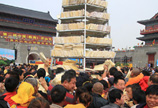Questions remain over safety of bottled water
By Wu Wencong (China Daily) Updated: 2011-08-16 07:55
![A production line of bottled water at Beijing Kangtai Gaoke. [Photo / China Daily] Questions remain over safety of bottled water](../../attachement/jpg/site1/20110816/0013729e48090fb3f3310a.jpg) |
|
A production line of bottled water at Beijing Kangtai Gaoke. [Photo / China Daily] |
The biggest risks occur after the filled bottles leave the production plant.
Few companies in the industry have retail operations. Instead they rely on dealers and distributors to sell and deliver their water, and that's when they lose control of their products.
"Some distributors simply pump tap water into the bottles that are labeled as famous brands. Some replace qualified bottles with substandard ones," Li said. "The authorities care most about the producers. There is hardly any supervision in this segment."
Even when the water reaches the customer, risks remain.
The large jugs require the use of a water dispenser. Li said many people think the dispensers are convenient and safe but don't think to clean them often enough. They also should consume the water within a week, he said.
"What they usually don't know," he said, "is that once the barrel is loaded onto the dispenser, air and dust start to come inside, making it a comfortable reproduction site for germs."
Air has to be introduced into the barrel to allow water to drop into the dispenser. That's the process that produces the large, sometimes loud bubbling.
Li and his colleagues once performed an experiment that produced countless bacterial colonies in the water within four days.
"Once the seal is opened, the water must be stored in a place with no direct sunshine and be finished within a week," Li said. "And the dispenser should be cleaned at least every month."
Despite all the potential risks, Li said, water from the 18.9-liter bottles is a safer choice than tap water and water from the automated sellers installed outside many communities. But he urged consumers to learn more about drinking water.
"The quality of life is determined by the quality of water," Li said.
- Seven villagers murdered in N China
- China steps up tobacco control efforts
- Five jailed for separatism in Xinjiang
- Letter asks for leniency in poisoning case
- Antibiotics in surface water pose 'indirect health risk'
- Tianjin airport opens up transit link to Beijing
- High levels of antibiotics in China's major rivers
- China to dig tunnel for Asian rail system
- Bering strait line to US possible, experts say
- China: Stop oil rig harassment







